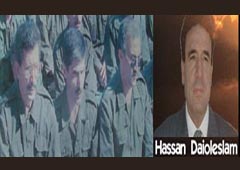In my last post, I noted that Hassan Daioleslam — the man at the center of the ongoing NIAC controversy — has been “said by multiple sources to be affiliated with the Mujahedin-e Khalq 
Massoud Khodabandeh, former MEK member who is now a leading expert on and critic of the group: “I can say without doubt that Hassan Daioleslam is a member of what I call for accuracy ‘the Rajavi cult’ [referring to MEK leaders Massoud and Maryam Rajavi]. In this respect he is obedient to the Rajavi leadership and would not act in a way inconsistent with their requirements and certainly not without their knowledge or consent (if not to say actual order). The term ‘membership’ describes his relationship to the Rajavis. The MKO, just like Al Qaida, does not have ‘membership cards’. But I doubt very much the MKO would deny that he is a member, just as they never have denied that Alireza Jafarzadeh is a member. Daioleslam’s writing is on the MKO websites. They do not publish just anyone’s writing. Only those obeying organisational constraints.”
Mohammad Hussein Sobhani, former high-ranking MEK member who the group held in solitary confinement for over eight years and then turned over to Saddam Hussein’s security forces for his dissent from offical MEK policies: “Hassan Daioleslam, who is also considered as a member of the Mojahedin Khalq Organisation (Rajavi Cult) had been under harsh criticism for a long time by the cult leader Massoud Rajavi because he would not leave the USA and join the cult under the rule of Saddam Hussein in Iraq.
But now, in the new circumstances in which the remnants of the Rajavi cult after the fall of Saddam Hussein find themselves in western countries, Hassan’s social position and his ability to speak English has grabbed the attention of Rajavi. He seems to be next in line to be consumed [for the group’s interests].” (Taken from a 2007 article by Sobhani; read the whole thing for a fuller description of the Daioleslam family’s deep involvement with the MEK. Daioleslam’s brother Hossein and sister Fatemeh are both leading MEK members.)
Mehdi Noorbaksh, professor of international affairs at Harrisburg University: “I know Daioleslam very closely and personally. He is not a journalist but a perfume merchant. He was a former member of MKO who was critical of the organization for many years. He was living in Europe for several years until he moved to the United States in Phoenix, Arizona. He was re-bought by MKO one more time and he is now active in selling and defending the positions of this terrorist organization. Those who know him know well that his commitment to MKO is opportunistic.”
Other knowledgeable parties have also spoken privately to me about Daioleslam’s MEK ties; anyone with further information they would like to share publicly should feel free to contact me.
For more background on the MKO, see the State Department’s description of the group on its terrorism page. Human Rights Watch also released a report in 2005 detailing the group’s record of subjecting dissident members to torture and solitary confinement.
Founded as a militant group with an ideology combining aspects of Islam and Marxism, the group is frequently described today as “cult-like,” built around a personality cult centered on leader Maryam Rajavi. The State Department notes that members are “required to undertake a vow of ‘eternal divorce’ and participate in weekly ‘ideological cleansings,’” and that “children are reportedly separated from parents at a young age.” After Rajavi was arrested in France in 2003 on suspicions of plotting terrorism, MKO members throughout Europe protested by setting themselves on fire; two of them died.
The group’s hatred of the Islamic Republic led it to ally with Saddam Hussein, and it fought on the Iraqi side of the Iran-Iraq war in the 1980s. Following the Gulf War, “the group reportedly assisted in the Iraqi Republican Guard’s bloody crackdown on Iraqi Shia and Kurds who rose up against Saddam Hussein’s regime; press reports cite MEK leader Maryam Rajavi encouraging MEK members to ‘take the Kurds under your tanks,’” according to the State Department. The group’s alliance with Saddam made it widely despised among the Iranian community at large, as it remains to this day.
However, its militant anti-Iranian stance has made it a favorite of hawks in Washington. Several of them — most notably Rep. Tom Tancredo (R-CO) — participated in a 2005 Washington conference in support of the group. The same year also saw the founding of the pro-MEK Iran Policy Committee, headed by Raymond Tanter of the Washington Institute for Near East Policy (WINEP). The MEK’s neoconservative supporters continue to push for it to be taken off the State Department terror list, which it has been on since 1997. One of the many ironies about the MEK is that, for all the groundless allegations that hawks made about Saddam Hussein’s connections to terrorist groups during the runup to the Iraq war, the terrorist group with perhaps the closest links to Saddam was one that the hawks themselves supported.
So it seems that the neoconservatives who have gotten in bed with Daioleslam may have some explaining to do. If he is indeed an MEK operative, as the evidence strongly suggests, then he is, to say the least, a rather unlikely standard-bearer for the cause of democracy and human rights in Iran.
By Daniel Luban – Cross-posted on The Faster Times
